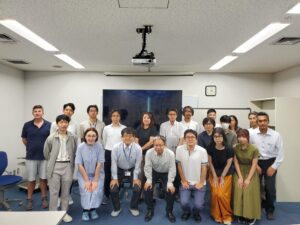 The 171st Brain Club was held on October 2, 2025, co-sponsored by WPI-BIo2Q. This time, Dr. Kiyonaka Shigeki (Professor, Department of Biomolecular Engineering, Graduate School of Engineering, Nagoya University;We welcomed the lecturer to the Institute for Quantum Chemical Innovation, the Future Society Creation Organization (Director of the Institute for Quantum Chemical Innovation).。The topic is "Visualization of native receptors and development of cell-selective regulation techniques for elucidating higher brain functions."。Dr. Kiyonaka and others、Towards elucidating brain function、Integrated in neurons and glial cellsWe are developing receptor visualization and regulation technologies。In particular, we provide a precise and quantitative solution to the dynamic changes of glutamate receptors, which hold the key to the molecular mechanisms of memory and learning.We were introduced to the chemical methodology for analyzing。Also、Existing chemogenetics are cell-controlledIn contrast to the resolution、Endogenous receptorsWe also talked about technology to increase the time resolution that corresponds to activation.。I was once again impressed by the magical chemical modifications and compound synthesis based on the structure of receptors.。We hope to continue to elucidate brain functions through collaborative research using new tools.。
The 171st Brain Club was held on October 2, 2025, co-sponsored by WPI-BIo2Q. This time, Dr. Kiyonaka Shigeki (Professor, Department of Biomolecular Engineering, Graduate School of Engineering, Nagoya University;We welcomed the lecturer to the Institute for Quantum Chemical Innovation, the Future Society Creation Organization (Director of the Institute for Quantum Chemical Innovation).。The topic is "Visualization of native receptors and development of cell-selective regulation techniques for elucidating higher brain functions."。Dr. Kiyonaka and others、Towards elucidating brain function、Integrated in neurons and glial cellsWe are developing receptor visualization and regulation technologies。In particular, we provide a precise and quantitative solution to the dynamic changes of glutamate receptors, which hold the key to the molecular mechanisms of memory and learning.We were introduced to the chemical methodology for analyzing。Also、Existing chemogenetics are cell-controlledIn contrast to the resolution、Endogenous receptorsWe also talked about technology to increase the time resolution that corresponds to activation.。I was once again impressed by the magical chemical modifications and compound synthesis based on the structure of receptors.。We hope to continue to elucidate brain functions through collaborative research using new tools.。
posted on 10/05/2025 2:35 PM
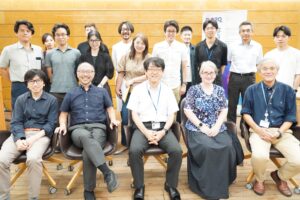 The 170th Brain Club was held on September 3, 2025, co-hosted with WPI-BIo2Q. This time, Dr. Yasuda Ryoheio (Max Planck Florida Institute for Neuroscience and Scientific Director) was invited as the lecturer.。The theme is "Decoding Synaptic Signaling Dynamics Underlying Plasticity"is。Behavioral Time Scale Plasticity (BTSP) is、It has attracted attention as synaptic plasticity that occurs on time scales (in seconds) related to individual-level learning.、The molecular mechanism is unknown。Dr. Yasuda and colleagues explored this problem using improved Ca2+/calmodulin-dependent kinase II (CaMKII) sensors.、10-100 seconds after BTSP induction、Delayed CaMKII activation in the dendrites was found to occur stocastically.、It was discovered that IP3-dependent intracellular Ca2+ release is involved in this phenomenon。It was an extremely interesting story that explored the individual-level learning mechanisms.。
The 170th Brain Club was held on September 3, 2025, co-hosted with WPI-BIo2Q. This time, Dr. Yasuda Ryoheio (Max Planck Florida Institute for Neuroscience and Scientific Director) was invited as the lecturer.。The theme is "Decoding Synaptic Signaling Dynamics Underlying Plasticity"is。Behavioral Time Scale Plasticity (BTSP) is、It has attracted attention as synaptic plasticity that occurs on time scales (in seconds) related to individual-level learning.、The molecular mechanism is unknown。Dr. Yasuda and colleagues explored this problem using improved Ca2+/calmodulin-dependent kinase II (CaMKII) sensors.、10-100 seconds after BTSP induction、Delayed CaMKII activation in the dendrites was found to occur stocastically.、It was discovered that IP3-dependent intracellular Ca2+ release is involved in this phenomenon。It was an extremely interesting story that explored the individual-level learning mechanisms.。
posted on 09/05/2025 2:10 PM
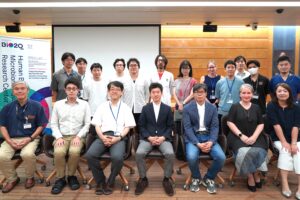 The 169th Brain Club was held on July 28, 2025, co-sponsored by WPI-BIo2Q. This time, we welcomed Dr. Hasegawa Tetsuo (Leader of the Immunology Unit, Institute of Medicine, Cambridge University) as our lecturer.。The presentation is "3D imaging of the synovium defines an intricate immunological defense system at the blood-joint barrier". Joint pain is a systemic inflammation、Often observed。This phenomenon is thought to be mediated by circulating IgG immune complexes.、The cause was not well understood。Dr. Hasegawa、This problem was solved by developing a new technique to observe the entire synovium of the mouse knee joint。Beautiful 3D imaging of synovium、Everyone once again felt the importance of "seeing" in the way new insights can bring to mind.。
The 169th Brain Club was held on July 28, 2025, co-sponsored by WPI-BIo2Q. This time, we welcomed Dr. Hasegawa Tetsuo (Leader of the Immunology Unit, Institute of Medicine, Cambridge University) as our lecturer.。The presentation is "3D imaging of the synovium defines an intricate immunological defense system at the blood-joint barrier". Joint pain is a systemic inflammation、Often observed。This phenomenon is thought to be mediated by circulating IgG immune complexes.、The cause was not well understood。Dr. Hasegawa、This problem was solved by developing a new technique to observe the entire synovium of the mouse knee joint。Beautiful 3D imaging of synovium、Everyone once again felt the importance of "seeing" in the way new insights can bring to mind.。
posted on 07/28/2025 12:28 PM
 Gordon Research Conference held at New Hampshire from June 8th to 13th (The topic was on the Excitatory Synapses and Brain Function) .。Oishi Mitsuhiro-kun, a graduate student who accompanied him, made a poster presentation.、He has achieved the great achievement of being selected as a poster award from among the many excellent poster presentations.。13After the GRC, we visited Harvard Medical School and held a seminar hosted by Dr. Pascal Kaeser.。Photo: Nozawa, who is studying abroad at Kaeser Research Institute.、Oishi-kun、Dinner with Pascal (after meals)。
Gordon Research Conference held at New Hampshire from June 8th to 13th (The topic was on the Excitatory Synapses and Brain Function) .。Oishi Mitsuhiro-kun, a graduate student who accompanied him, made a poster presentation.、He has achieved the great achievement of being selected as a poster award from among the many excellent poster presentations.。13After the GRC, we visited Harvard Medical School and held a seminar hosted by Dr. Pascal Kaeser.。Photo: Nozawa, who is studying abroad at Kaeser Research Institute.、Oishi-kun、Dinner with Pascal (after meals)。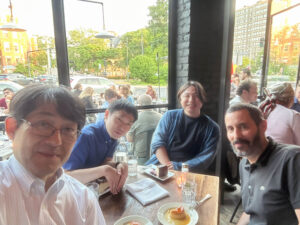
posted on 06/16/2025 12:25 AM
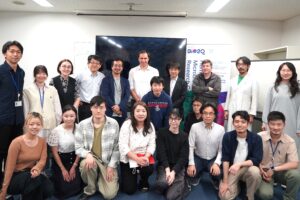 The 168th Brain Club was held on April 25, 2025, co-hosted with WPI-BIo2Q. This time, Dr. Eric Hosy (IINS) will be the lecturer., CNRS-University of Bordeaux, Bordeaux, France) welcomed。The presentation is "Super-resolution microscopy to resolve the intimate organization and function of the synapse.". Dr. Hosy is one of the developers of PAINT technology.、Using this technology and super-resolution microscopes such as STORM, we observe multiple synaptic molecules at a spatial resolution of approximately 10 nm.、We talked about changes in localization of synaptic molecules before and after synaptic plasticity.
The 168th Brain Club was held on April 25, 2025, co-hosted with WPI-BIo2Q. This time, Dr. Eric Hosy (IINS) will be the lecturer., CNRS-University of Bordeaux, Bordeaux, France) welcomed。The presentation is "Super-resolution microscopy to resolve the intimate organization and function of the synapse.". Dr. Hosy is one of the developers of PAINT technology.、Using this technology and super-resolution microscopes such as STORM, we observe multiple synaptic molecules at a spatial resolution of approximately 10 nm.、We talked about changes in localization of synaptic molecules before and after synaptic plasticity.
posted on 04/22/2025 5:11 PM
It has been announced that the International Union of Physiological Societies (IUPS))was establishedAcademy FellowHe was elected to。
IUPS was founded in 1889, and was founded by the International Conference on Physiological Sciences (Association for the Universal Physiology).、1953It is the only international academic organization representing the physiological researcher community, officially established in 2019.。Incidentally, Dr. Kato Motoichi, the first professor of physiology at Keio University School of Medicine, was first published internationally on unattenuated conduction at the IUPS Congress held in Stockholm in 1926.。
posted on 04/22/2025 11:32 AM
Associate Professor Kakegawa will be promoted to the Department of Life Sciences, Faculty of Science, Gakushuin University from April.。
We have been participating in Yuzuzaki Lab since April 2003, so we have been researching together for 22 years.。I wish you more and more success。
posted on 04/01/2025 9:00 AM
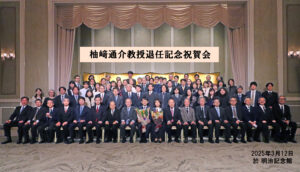 3On the 12th of the month, Yuzuzaki gave a final lecture, "Bridge Over Troubled Synapse: C1q protein、wheels、And then beyond"I did it。movieHere。
3On the 12th of the month, Yuzuzaki gave a final lecture, "Bridge Over Troubled Synapse: C1q protein、wheels、And then beyond"I did it。movieHere。
We then held a celebration of the resignation ceremony at the Meiji Memorial Museum.。Researchers who once again conducted research together in the lab、Maya Kono、technician、Secretaries、Furthermore, to all those involved in the Faculty of Medicine and Keio University.、We would like to express our sincere gratitude。photographHere。
4From Monday onwards, I will be transferred to Keio University WPI-Bio2Q.、I had the opportunity to continue my research。in recent years、.、schizophrenia、Many mental and neurological disorders such as autism spectrum disorders and developmental disorders、It is becoming increasingly thought to be a "synaptic disease" caused by synaptic abnormalities。Until now, I、We investigate how central nervous system synapses are formed and maintained.、Based on this knowledge, we have aimed to clarify the pathology of synaptic disease and develop treatment methods.。In WPI-Bio2Q、In addition to the central nervous system、Enteroinal nervous system、Autonomic nervous system、Peripheral nervous system、Furthermore, we will continue our research focusing on the synapse formation mechanism that connects these nervous systems with each organ.。With this approach、Understand the mechanism by which multiple organs connect to each other and maintain homeostasis、We hope to help you understand the pathology of diseases and develop new treatments。
posted on 03/12/2025 8:42 PM
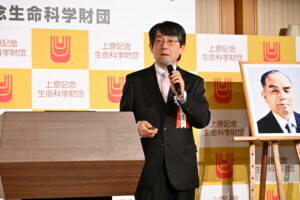 Yuzuzaki is2024Uehara Prize in 2019Awarded、The award ceremony was held on March 11th.。It was a great opportunity to receive this award with Dr. Kamitori Hideki from Nagoya Institute of Technology, who has been doing joint research on Optogenetics Tools.。”
Yuzuzaki is2024Uehara Prize in 2019Awarded、The award ceremony was held on March 11th.。It was a great opportunity to receive this award with Dr. Kamitori Hideki from Nagoya Institute of Technology, who has been doing joint research on Optogenetics Tools.。”
The award-winning lecture will be available on YouTubeIt is listed in。Suddenly, the screen was pitch black and I was panicked.。
posted on 03/11/2025 8:03 PM
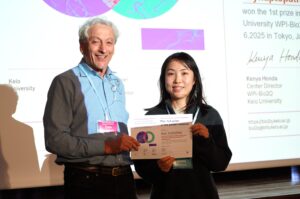 3It was held on the 7th of the monthThe 3rd Keio University WPI-Bio2Q International SymposiumAt the poster presentation held at、Graduate student Shiozaki won the Poster Award (first prize).。
3It was held on the 7th of the monthThe 3rd Keio University WPI-Bio2Q International SymposiumAt the poster presentation held at、Graduate student Shiozaki won the Poster Award (first prize).。
posted on 03/07/2025 8:13 PM
As usual、Targeting 20 first-year students at Gakugei University High School、Lectures were given to convey the fun of biology and medicine.。
This year、It was co-sponsored by Bio2Q under the following program。
3:35-14:20 A story about synapsesProfessor Yuzusaki Tsutosuke, Neurophysiology, WPI-Bio2Q, Keio University School of Medicine
14:25-15:10 A story about the genes and immune systemIshigaki Kazuyoshi, Professor, WPI-Bio2Q, Keio University School of Medicine
15:15-15:25 Introducing WPI-Bio2QProfessor San Petra Orthea, WPI-Bio2Q, Keio University
(Yuzuzaki is for the post-coronavirus infection、Unfortunately I attended online。)
posted on 02/04/2025 2:50 PM
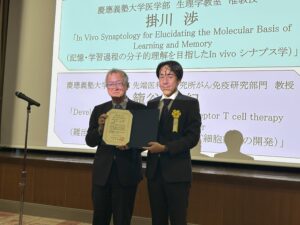 Associate Professor Wataru Kakegawa was awarded the 2024 Tatsuji Nomura Award.、11The award ceremony was held on March 30th at Kitasato Auditorium.。congratulations。Dr. Tatsuji Nomura is the Chairman of the Central Research Institute for Experimental Animals.、Consistent as director from beginning to end、He devoted his life to establishing the animal experiment system that is essential for the development of medicine.。This award was established to honor the achievements of Dr. Akihiro, who has dedicated himself to the development of "in vivo experimental medicine."。The concurrent award recipient is Professor Yuki Kagotani of the Cancer Immunology Research Department, Institute of Advanced Medical Sciences.。
Associate Professor Wataru Kakegawa was awarded the 2024 Tatsuji Nomura Award.、11The award ceremony was held on March 30th at Kitasato Auditorium.。congratulations。Dr. Tatsuji Nomura is the Chairman of the Central Research Institute for Experimental Animals.、Consistent as director from beginning to end、He devoted his life to establishing the animal experiment system that is essential for the development of medicine.。This award was established to honor the achievements of Dr. Akihiro, who has dedicated himself to the development of "in vivo experimental medicine."。The concurrent award recipient is Professor Yuki Kagotani of the Cancer Immunology Research Department, Institute of Advanced Medical Sciences.。
posted on 12/01/2024 1:13 PM
 The 171st Brain Club was held on October 2, 2025, co-sponsored by WPI-BIo2Q. This time, Dr. Kiyonaka Shigeki (Professor, Department of Biomolecular Engineering, Graduate School of Engineering, Nagoya University;We welcomed the lecturer to the Institute for Quantum Chemical Innovation, the Future Society Creation Organization (Director of the Institute for Quantum Chemical Innovation).。The topic is "Visualization of native receptors and development of cell-selective regulation techniques for elucidating higher brain functions."。Dr. Kiyonaka and others、Towards elucidating brain function、Integrated in neurons and glial cells
The 171st Brain Club was held on October 2, 2025, co-sponsored by WPI-BIo2Q. This time, Dr. Kiyonaka Shigeki (Professor, Department of Biomolecular Engineering, Graduate School of Engineering, Nagoya University;We welcomed the lecturer to the Institute for Quantum Chemical Innovation, the Future Society Creation Organization (Director of the Institute for Quantum Chemical Innovation).。The topic is "Visualization of native receptors and development of cell-selective regulation techniques for elucidating higher brain functions."。Dr. Kiyonaka and others、Towards elucidating brain function、Integrated in neurons and glial cells






